Badminton Serve
A badminton serve can be performed using 2 methods (high serve and low serve), depending on where you want the shuttlecock to land.
There are certain rules that you must follow when making a service. Checkout the badminton service fouls to avoid it.
The Importance of a Good Badminton Serve
A WEAK serve often creates a chance for your opponent to execute an attacking shot. Therefore it’s important to know how to serve properly so that you will not lose a point after making a service.
1. The High Badminton Serve
This type of serve is usually executed when you want the shuttle to land at the back end of the court. A good high serve must have the shuttle dropping steeply downwards at the back end of the court.
A high serve will prevent your opponent from executing a strong smash. Instead, a lob or a drop is more expected from your opponent (unless they can do a jump smash).
Try to serve the shuttlecock to your opponent’s backhand area. The objective is to force your opponent to use his backhand. This is because most badminton players, even world class player, have weaker backhands (compared to their forehands)
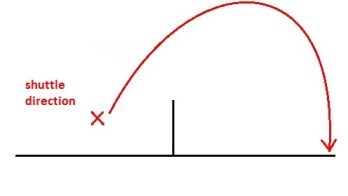
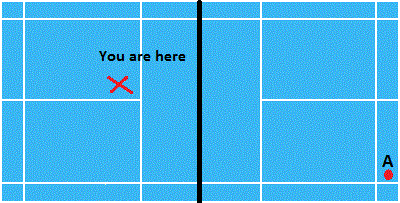
For example, you’re standing at X. You are about to make a high serve… and your opponent is right handed. In that case, direct the shuttle to drop at point A.
This will force your opponent to use the backhand and hence there’s a higher chance that he’ll return a weak shot.
If your hit it to your opponent’s backhand area, but he/she refuses to use the backhand, he will then have to move further away from his base! This gives you the chance to exploit an opportunity to control the game if your opponent does not have good badminton footwork.
Let me show you how to do a high serve…
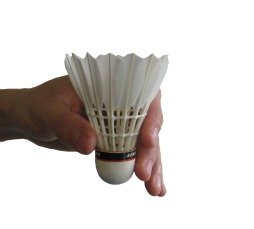
- Hold the head of the shuttlecock with its head facing downwards so that the shuttlecock will drop straight down.
- Stand sideways (the side of your body facing the net) and relax your racquet arm (arm that is holding the racquet).
- Let go of the shuttlecock and swing your racquet arm upwards. As you do this, twist your waist to the extent that your body faces the net. Flick your wrist towards the direction you want the shuttle to land (Flick your wrist upwards, so that the shuttlecock will fly high).
- Your back leg should lift up naturally (with your toes touching the ground).
The high serve is useful against opponents who cannot perform strong smashes from the back of the court.
However, some badminton players (especially taller players) can execute powerful smashes even from the back of the court (usually with a jumping smash).
If this is the case, consider using the low serve instead. This is also the reason why professional players nowadays prefer using the low serve.
2.The Low Badminton Serve
The low serve is used when you want the shuttlecock to land in front of the court (in front of your opponent).
A GOOD low serve will have the shuttlecock flying JUST ABOVE THE NET.
If not, your opponent will have the chance to dash forward and smash the shuttle down to you.
A low serve, when executed beautifully, prevents your opponent from making an offensive shot.
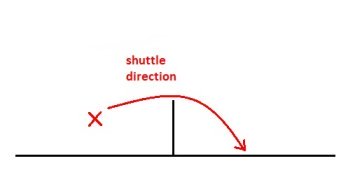
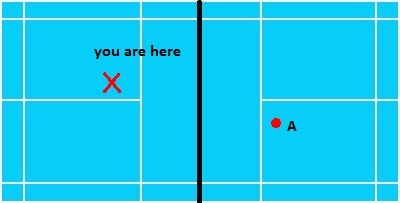
Unlike the high serve, you can let the shuttle drop anywhere in front (forehand area or backhand area of your opponent)
Neither makes a difference because it does not disrupt your opponent’s footwork.
As a start, practice serving so that the shuttle drops right in front of your opponent (point A in picture above).
Let me show you how to do a low serve…
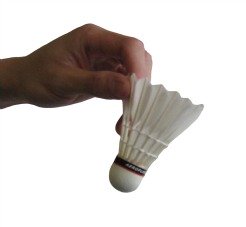
- Hold the feather of the shuttlecock with the head of the shuttlecock facing downwards.
- Position the racquet behind the shuttlecock.
- Step slightly forward with your right (left) leg if you are right handed (left handed).
- As you let go of the shuttlecock, flick your racquet lightly while pushing your thumb forward towards the direction you want the shuttle to land. The power comes mainly from the push of your thumb and the slight flick of your wrist.
3.The Flick Serve (“Fake” Low Serve)
The “fake” low badminton serve can also be used to trick your opponent (deceive your opponent to expect a low serve).
When you stand in a low serve position, your opponent would probably expect a low serve. However, push your thumb and flick your wrist harder so the shuttlecock flies HIGH and heads to the back of the court!
Well, knowing how to serve is one thing. Practising is another. If you want to make perfect serves, keep practising until you don’t make any mistakes!
Like Masterbadminton.com?

Tell me what you think!
What do you think about what you just read? Leave me a comment below.